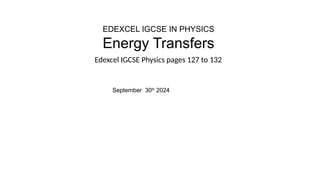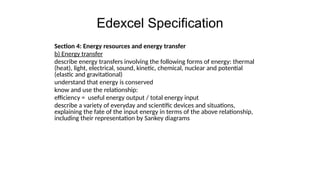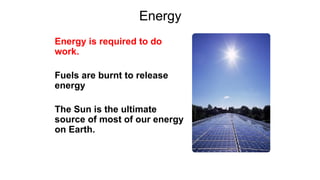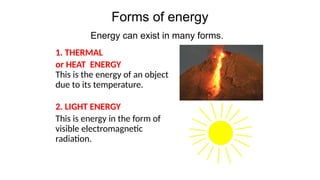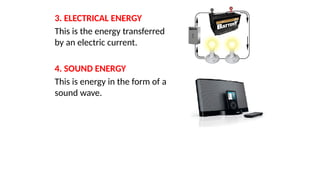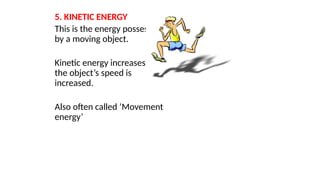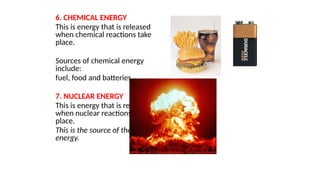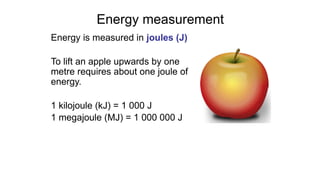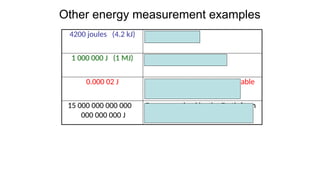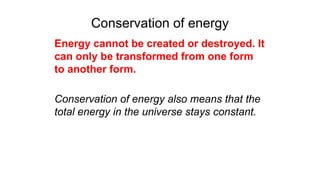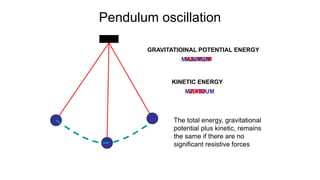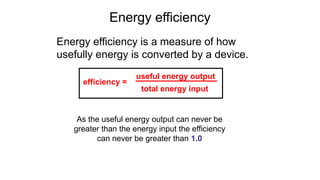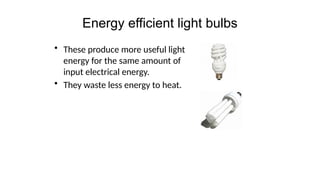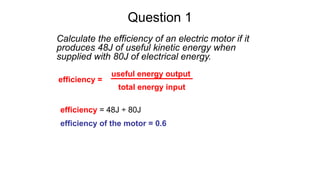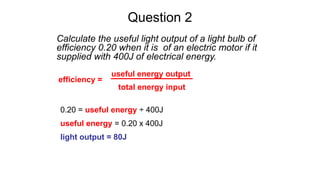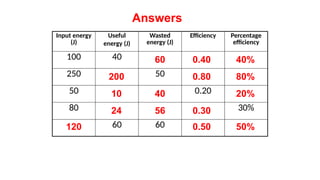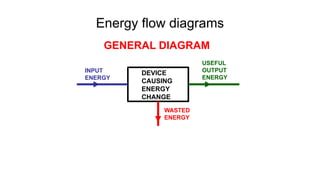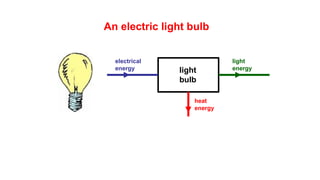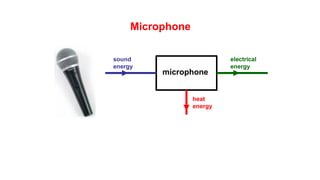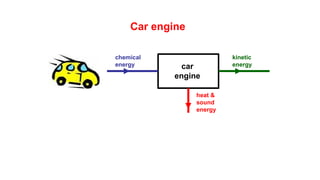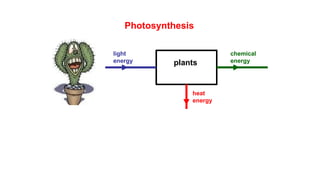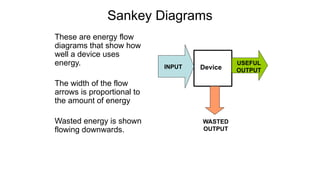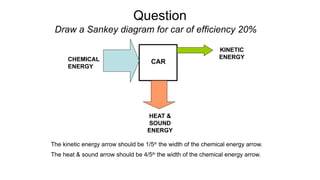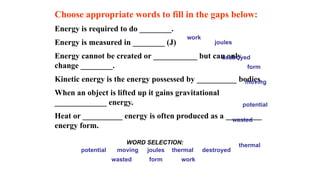ENERGY PRESENTATION, EDEXCEL PHYSICS from page 127 to 192
- 1. EDEXCEL IGCSE IN PHYSICS Energy Transfers Edexcel IGCSE Physics pages 127 to 132 September 30th 2024
- 2. Edexcel Specification Section 4: Energy resources and energy transfer b) Energy transfer describe energy transfers involving the following forms of energy: thermal (heat), light, electrical, sound, kinetic, chemical, nuclear and potential (elastic and gravitational) understand that energy is conserved know and use the relationship: efficiency = useful energy output / total energy input describe a variety of everyday and scientific devices and situations, explaining the fate of the input energy in terms of the above relationship, including their representation by Sankey diagrams
- 3. Energy Energy is required to do work. Fuels are burnt to release energy The Sun is the ultimate source of most of our energy on Earth.
- 4. Forms of energy 1. THERMAL or HEAT ENERGY This is the energy of an object due to its temperature. 2. LIGHT ENERGY This is energy in the form of visible electromagnetic radiation. Energy can exist in many forms.
- 5. 3. ELECTRICAL ENERGY This is the energy transferred by an electric current. 4. SOUND ENERGY This is energy in the form of a sound wave.
- 6. 5. KINETIC ENERGY This is the energy possessed by a moving object. Kinetic energy increases as the objectŌĆÖs speed is increased. Also often called ŌĆśMovement energyŌĆÖ
- 7. 6. CHEMICAL ENERGY This is energy that is released when chemical reactions take place. Sources of chemical energy include: fuel, food and batteries. 7. NUCLEAR ENERGY This is energy that is released when nuclear reactions take place. This is the source of the SunŌĆÖs energy.
- 8. 8. POTENTIAL ENERGY This is the energy possessed by an object due to its position. Gravitational Potential Energy The gravitational potential energy of an object increases if it is raised upwards. Elastic Potential Energy Gravitational potential energy being converted into kinetic energy. This is the energy stored in a stretched or squashed object - also known as strain energy
- 9. Energy measurement Energy is measured in joules (J) To lift an apple upwards by one metre requires about one joule of energy. 1 kilojoule (kJ) = 1 000 J 1 megajoule (MJ) = 1 000 000 J
- 10. Other energy measurement examples 4200 joules (4.2 kJ) 1 food Calorie 1 000 000 J (1 MJ) Energy of a Mars bar 0.000 02 J Energy need to produce a syllable of a word 15 000 000 000 000 000 000 000 J Energy received by the Earth from the Sun in one day
- 11. Conservation of energy Energy cannot be created or destroyed. It can only be transformed from one form to another form. Conservation of energy also means that the total energy in the universe stays constant.
- 12. Pendulum oscillation GRAVITATIOINAL POTENTIAL ENERGY KINETIC ENERGY MAXIMUM MINIMUM MAXIMUM ZERO The total energy, gravitational potential plus kinetic, remains the same if there are no significant resistive forces
- 13. Useful and wasted energy Useful energy is energy transferred to where it is required in the form that it is wanted. Other forms of energy are referred to as ŌĆśwastedŌĆÖ. Wasted energy spreads out into the surroundings. This is usually in the form of heat energy causing the energy changing device and its surroundings to become warmer. It is very difficult to ŌĆśconcentrateŌĆÖ this energy again to make use of it.
- 14. Energy efficiency Energy efficiency is a measure of how usefully energy is converted by a device. As the useful energy output can never be greater than the energy input the efficiency can never be greater than 1.0 efficiency = useful energy output total energy input
- 15. Energy efficient light bulbs ŌĆó These produce more useful light energy for the same amount of input electrical energy. ŌĆó They waste less energy to heat.
- 16. Question 1 Calculate the efficiency of an electric motor if it produces 48J of useful kinetic energy when supplied with 80J of electrical energy. efficiency = useful energy output total energy input efficiency = 48J ├Ę 80J efficiency of the motor = 0.6
- 17. Question 2 Calculate the useful light output of a light bulb of efficiency 0.20 when it is of an electric motor if it supplied with 400J of electrical energy. 0.20 = useful energy ├Ę 400J useful energy = 0.20 x 400J light output = 80J efficiency = useful energy output total energy input
- 18. Percentage efficiency percentage efficiency = efficiency x 100 The greater the percentage of the energy that is usefully transformed in a device, the more efficient the device is. The maximum percentage efficiency is 100%
- 19. Question Calculate the percentage efficiency of a light bulb if it produces 30J of light when supplied with 240J of electrical energy. efficiency = 30J ├Ę 240J = 0.125 % efficiency = efficiency x 100 Percentage efficiency of light bulb = 12.5% efficiency = useful energy output total energy input
- 20. Complete Input energy (J) Useful energy (J) Wasted energy (J) Efficiency Percentage efficiency 100 40 250 50 50 0.20 80 30% 60 60 60 200 10 40 24 56 120 0.80 0.50 0.30 20% 0.40 80% 50% 40% Answers
- 21. Improving efficiency Decrease loss to heat by: Reducing friction by using a lubricant (eg oil). Reducing electrical resistance in electrical circuits. Reducing air resistance by using streamlined shapes. Reduce loss to sound by tightening the loose parts of machinery.
- 22. Energy flow diagrams GENERAL DIAGRAM DEVICE CAUSING ENERGY CHANGE INPUT ENERGY WASTED ENERGY USEFUL OUTPUT ENERGY
- 23. An electric light bulb light bulb electrical energy heat energy light energy
- 27. Complete the table below: Device Input energy Main output energy Electric motor electrical Car brakes heat gravitational potential kinetic Candle light Generator electrical kinetic kinetic chemical kinetic Falling object
- 28. Sankey Diagrams These are energy flow diagrams that show how well a device uses energy. The width of the flow arrows is proportional to the amount of energy Wasted energy is shown flowing downwards. Device INPUT USEFUL OUTPUT WASTED OUTPUT
- 29. Question Draw a Sankey diagram for car of efficiency 20% CAR CHEMICAL ENERGY KINETIC ENERGY HEAT & SOUND ENERGY The kinetic energy arrow should be 1/5th the width of the chemical energy arrow. The heat & sound arrow should be 4/5th the width of the chemical energy arrow.
- 30. Choose appropriate words to fill in the gaps below: Energy is required to do ________. Energy is measured in ________ (J) Energy cannot be created or ___________ but can only change ________. Kinetic energy is the energy possessed by __________ bodies. When an object is lifted up it gains gravitational _____________ energy. Heat or __________ energy is often produced as a _________ energy form. work form moving joules potential thermal destroyed WORD SELECTION: wasted work form moving joules potential thermal destroyed wasted
- 31. Energy Transfers Notes questions from pages 127 to 132 1. (a) What is energy? (b) State the unit of energy. (see page 127) 2. Give examples of the following energy changes: (a) electrical to light; (b) kinetic to sound; (c) nuclear to light; (d) chemical to gravitational potential; (e) elastic potential to thermal. (see pages 128 and 129) 3. State the law of conservation of energy and give an example (see pages 129 and 130) 4. Sketch a Sankey diagram showing the energy flow in an electric light bulb. (see pages 130 and 131) 5. Define (a) efficiency; (b) percentage efficiency. Calculate both of these for an electric motor that uses 120J of electrical energy to output 90J of kinetic energy. (see page 131) 6. Answer the questions on page 132. 7. Verify that you can do all of the items listed in the end of chapter checklist on page 132.
